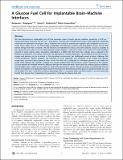| dc.contributor.author | Rapoport, Benjamin I. | |
| dc.contributor.author | Kedzierski, Jakub T. | |
| dc.contributor.author | Sarpeshkar, Rahul | |
| dc.date.accessioned | 2012-08-22T19:40:05Z | |
| dc.date.available | 2012-08-22T19:40:05Z | |
| dc.date.issued | 2011-06 | |
| dc.date.submitted | 2012-06 | |
| dc.identifier.uri | http://hdl.handle.net/1721.1/72329 | |
| dc.description.abstract | We have developed an implantable fuel cell that generates power through glucose oxidation, producing 3:4 mW cm{2steady-state power and up to 180 mW cm{2 peak power. The fuel cell is manufactured using a novel approach, employing semiconductor fabrication techniques, and is therefore well suited for manufacture together with integrated circuits on a single silicon wafer. Thus, it can help enable implantable microelectronic systems with long-lifetime power sources that harvest energy from their surrounds. The fuel reactions are mediated by robust, solid state catalysts. Glucose is oxidized at the nanostructured surface of an activated platinum anode. Oxygen is reduced to water at the surface of a self-assembled network of single-walled carbon nanotubes, embedded in a Nafion film that forms the cathode and is exposed to the biological environment. The catalytic electrodes are separated by a Nafion membrane. The availability of fuel cell reactants, oxygen and glucose, only as a mixture in the physiologic environment, has traditionally posed a design challenge: Net current production requires oxidation and reduction to occur separately and selectively at the anode and cathode, respectively, to prevent electrochemical short circuits. Our fuel cell is configured in a half-open geometry that shields the anode while exposing the cathode, resulting in an oxygen gradient that strongly favors oxygen reduction at the cathode. Glucose reaches the shielded anode by diffusing through the nanotube mesh, which does not catalyze glucose oxidation, and the Nafion layers, which are permeable to small neutral and cationic species. We demonstrate computationally that the natural recirculation of cerebrospinal fluid around the human brain theoretically permits glucose energy harvesting at a rate on the order of at least 1 mW with no adverse physiologic effects. Low-power brain–machine interfaces can thus potentially benefit from having their implanted units powered or recharged by glucose fuel cells. | en_US |
| dc.description.sponsorship | National Institutes of Health (U.S.) (grant NS-056140) | en_US |
| dc.description.sponsorship | United States. Office of Naval Research (grant N00014-09-1- 1015) | en_US |
| dc.description.sponsorship | United States. Defense Advanced Research Projects Agency (Research Assistantship to MIT Lincoln Laboratory) | en_US |
| dc.language.iso | en_US | |
| dc.publisher | Public Library of Science | en_US |
| dc.relation.isversionof | http://dx.doi.org/10.1371/journal.pone.0038436 | en_US |
| dc.rights | Creative Commons Attribution | en_US |
| dc.rights.uri | http://creativecommons.org/licenses/by/2.5/ | en_US |
| dc.source | PLoS | en_US |
| dc.title | A Glucose Fuel Cell for Implantable Brain–Machine Interfaces | en_US |
| dc.type | Article | en_US |
| dc.identifier.citation | Rapoport, Benjamin I., Jakub T. Kedzierski, and Rahul Sarpeshkar. “A Glucose Fuel Cell for Implantable Brain–Machine Interfaces.” Ed. Christophe Egles. PLoS ONE 7.6 (2012): e38436. Web. | en_US |
| dc.contributor.department | Whitaker College of Health Sciences and Technology | en_US |
| dc.contributor.department | Lincoln Laboratory | en_US |
| dc.contributor.department | Massachusetts Institute of Technology. Department of Electrical Engineering and Computer Science | en_US |
| dc.contributor.approver | Sarpeshkar, Rahul | |
| dc.contributor.mitauthor | Sarpeshkar, Rahul | |
| dc.contributor.mitauthor | Rapoport, Benjamin I. | |
| dc.contributor.mitauthor | Kedzierski, Jakub T. | |
| dc.relation.journal | PLoS ONE | en_US |
| dc.eprint.version | Final published version | en_US |
| dc.type.uri | http://purl.org/eprint/type/JournalArticle | en_US |
| eprint.status | http://purl.org/eprint/status/PeerReviewed | en_US |
| dspace.orderedauthors | Rapoport, Benjamin I.; Kedzierski, Jakub T.; Sarpeshkar, Rahul | en |
| dc.identifier.orcid | https://orcid.org/0000-0003-0384-3786 | |
| mit.license | PUBLISHER_CC | en_US |
| mit.metadata.status | Complete | |
